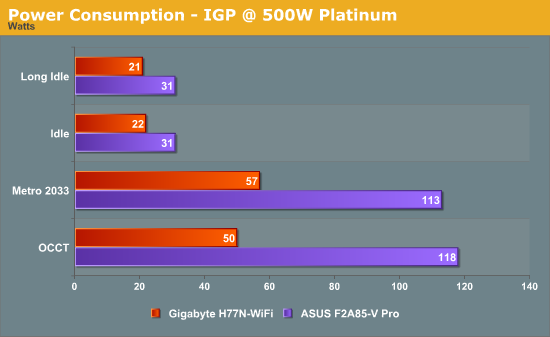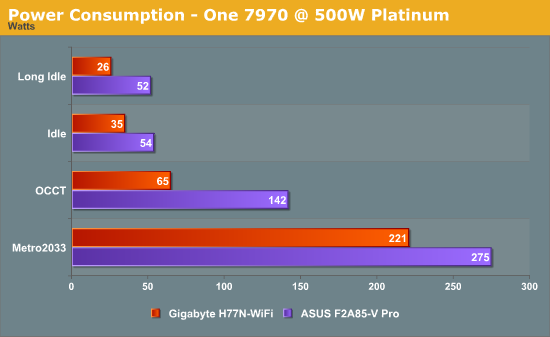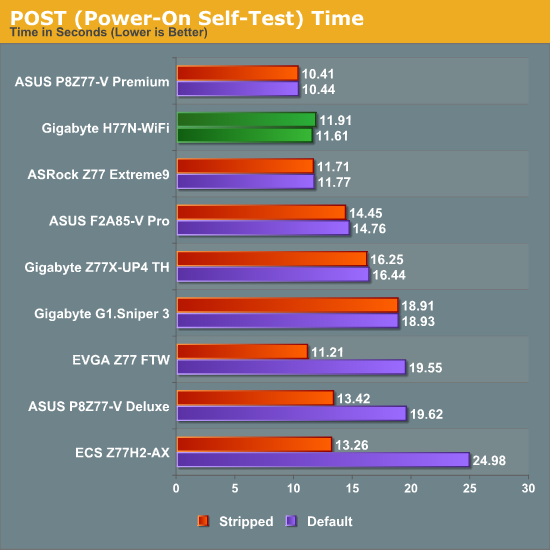Gigabyte H77N-WiFi Review – First Look at Ivy Bridge with mITX
by Ian Cutress on November 6, 2012 12:00 PM EST- Posted in
- Motherboards
- Gigabyte
- H77
- mITX
Many thanks to...
We must thank the following companies for kindly donating hardware for our test bed:
OCZ for donating the SSDs
Micron for donating our SATA testing SSD
G.Skill for donating our memory kits
ASUS for donating AMD GPUs and some IO Testing kit
ECS for donating NVIDIA GPUs
Gigabyte for donating the i3-3225 used for comparison
Rosewill for donating the Power Supply
Test Setup
| Test Bed | |
| Processor |
Intel Core i3-3225 @ 3.3 GHz 2 Cores, 4 Threads |
| Motherboards | Gigabyte H77N-WiFi |
| Cooling | Thermalright TRUE Copper |
| Power Supply | Rosewill SilentNight 500W |
| Memory | GSkill RipjawsX 2x4 GB DDR3-1600 9-9-9 |
| Memory Settings | XMP |
| Video Cards |
ASUS HD7970 3GB ECS GTX 580 1536MB |
| Video Drivers |
Catalyst 12.3 NVIDIA Drivers 296.10 WHQL |
| Hard Drive | OCZ Vertex 3 240GB |
| Optical Drive | LG GH22NS50 |
| Case | Open Test Bed - CoolerMaster Lab V1.0 |
| Operating System | Windows 7 64-bit |
| SATA Testing | OCZ Vertex 3 128GB |
| USB 2/3 Testing | OCZ Vertex 3 240GB with SATA->USB Adaptor |
Power Consumption
Power consumption was tested on the system as a whole with a wall meter connected to a Rosewill 500W 80PLUS Platinum SilentNight power supply. As I am in the UK on a 230-240 V supply, leads to ~75% efficiency at low loads, and 90%+ efficiency between 20% and 100% loading. This method of power reading allows us to compare the power management of the UEFI and the board to supply components with power under load, and includes typical PSU losses due to efficiency. These are the real world values that consumers may expect from a typical system (minus the monitor) using this motherboard.


Using the i3-3225 processor gives an amazing idle power usage – 21 W on IGP. Even with a 500W Platinum power supply, 21 W is still on the very low end of efficiency. I wouldn’t be surprised if the actual draw was more like 14-16 W.
POST Time
Different motherboards have different POST sequences before an operating system is initialized. A lot of this is dependent on the board itself, and POST boot time is determined by the controllers on board (and the sequence of how those extras are organized). As part of our testing, we are now going to look at the POST Boot Time - this is the time from pressing the ON button on the computer to when Windows starts loading. (We discount Windows loading as it is highly variable given Windows specific features.) These results are subject to human error, so please allow +/- 1 second in these results.

With the launch of Windows 8, most of the motherboard manufacturers are scrambling to update their BIOSes to take advantage of some of the Windows 8 features. This has resulted in reduced boot times – manufacturers that were taking 18 seconds to POST are down to 12 or below. I have been quoted that with the right combination of hardware and BIOS options, some setups can be in the operating system in 2-4 seconds. Nevertheless it also has a knock on affect for other operating systems – the Gigabyte H77N-WiFi is able to boot in a highly respectable 11.61 seconds with a 7970 attached.










52 Comments
View All Comments
IanCutress - Tuesday, November 6, 2012 - link
(1) The 15 W difference between OCCT load on IGP vs. 7970 seems alright to me. As the power goes up, the efficiency should rise, so for a 55W CPU having OCCT go on full and have a system load of 65W could be a little odd, depending on how OCCT is actually loading up the pipeline.(2) My main reason for testing with a 500W Platinum is that it is the lowest wattage PSU I have in, and I plan on putting a mITX board with that PSU into a Prodigy for my own usage. There are enough users out there willing to consider a SFF build for transportation but have enough horsepower to cart to events. Stick in a 3770K + 680 GPU (or 7970, 7870), and 500W doesn't seem too far fetched. Perhaps the platinum part does a little, but it does make our power readings a little closer to the true value, especially as I run on 240V which gives a higher efficiency.
Thanks for your comments :)
Termie - Tuesday, November 6, 2012 - link
Thank YOU for your review.You know, I think I was confused by the power consumption graphs because you switched the order of OCCT and Metro2033 in the IGP and HD7970 tests. Now that you explained it, I see that it makes sense.
HappyCracker - Tuesday, November 6, 2012 - link
I own the Z77 version of this board and it slid into my ISK nicely and seems to be the same basic layout as the Intel DH57JG it replaced.Here's what's confusing about this review. It's a review of the board, but in the computation and gaming benchmarks, is the only instance of a Core i3. I would probably like to see the same processor in each of those boards to show how they'd stack up for a potential buyer. Otherwise, what I see here, is a comparison of an i3 against i5s and i7s, which should belong in a CPU review and not a board review.
Or did I miss the methodology altogether?
IanCutress - Tuesday, November 6, 2012 - link
Our future Z77 mITX testing will be on the i3, but the main comparison point here in the CPU tests is the A10 which is at a similar price point. Stay tuned for the other mITX reviews :)Ian
Scotttnz - Tuesday, November 6, 2012 - link
I bought this board for my home esxi server. I chose this one due to it's reasonable price and for the dual on board NICs to give me internal and external connectivity for my firewall/ UTM vm. Esxi 5.1 installed fine to a micro USB key, and everything works well without any fiddling around injecting drivers etc. this leaves the pic-e slot free to add a RAID card or what ever.capeconsultant - Tuesday, November 6, 2012 - link
I am interested in building a mac mini type computer. Small, quiet and fast. Any ideas? Thanks!Gigaplex - Tuesday, November 6, 2012 - link
You're not going to get as small as a Mac Mini using mini-ITX. The Mini uses laptop grade parts with a custom motherboard designed around the case. If you want something Mini-like, just put Windows on the Mac Mini, or you're going to have to settle for the larger, more powerful mini-ITX systems - something like the Antec ISK 110 VESA is a good starting point if you're aiming for as small as you can get.http://www.anandtech.com/show/6192/antec-isk-110-v...
capeconsultant - Tuesday, November 6, 2012 - link
Thank you! I am this close to Windows on a mini, just exploring last minute ideas. Thanks for the advice. I am going to Google that case now just to learn. I have researched heavily the mac mini and think that will be prefect for me.MadMan007 - Tuesday, November 6, 2012 - link
The Z77 version is only $10 more on Newegg, so I don't see a reason not to get the Z77. At the very least it gives higher memory speed options which can help with the CPU integrated graphics.EnzoFX - Tuesday, November 6, 2012 - link
This has been intel's standard for like 3 years. People should stop pointing it out as strange, and cases/heatsinks can easily take it into account.